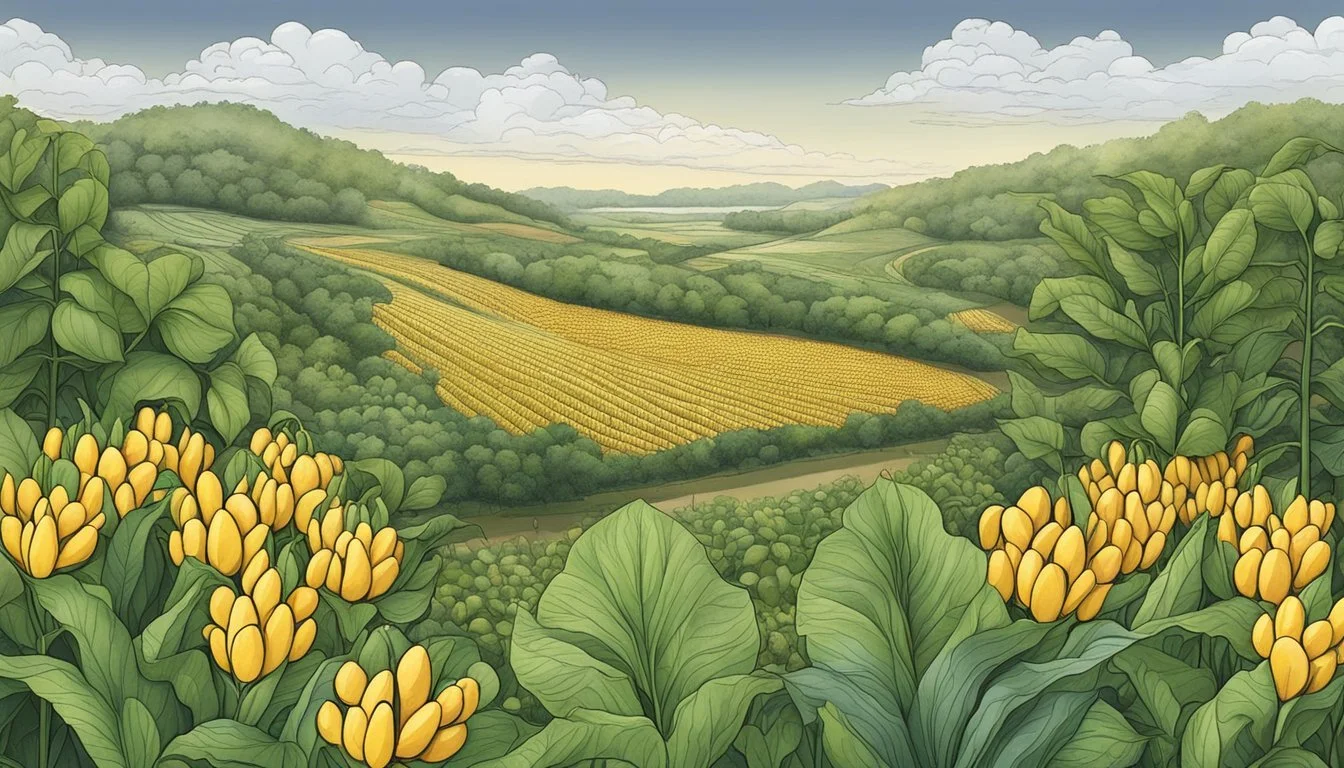Golden Triangle Native Edible Plants
Discovering Local Culinary Treasures
Golden Triangle Native Edible Plants provide a unique and sustainable option for gardeners and nature enthusiasts. These plants, native to regions such as California, are well-adapted to the local environment and offer a variety of delicious, edible options. Incorporating these plants into gardens not only supports local ecosystems but also promotes biodiversity.
In the Golden Triangle region, species like American cranberry, red maids, and thimbleberry are excellent choices for those interested in edible landscaping. American cranberry thrives in cooler climates with acidic, consistently moist soil, while red maids and thimbleberry can be tasty additions to meals, offering both aesthetic and culinary benefits.
By choosing native edible plants, gardeners can create beautiful, productive gardens that harmonize with the environment. These plants are typically better suited to resist local pests and diseases, reducing the need for chemical interventions. This makes native edible plants a perfect choice for those looking to cultivate a garden that is both productive and environmentally friendly.
Understanding Native Edible Plants
Native edible plants offer significant benefits to the ecosystem and play an important role in local cuisine. They are crucial for sustaining wildlife and pollinators and have historical significance for Native Americans as a source of sustenance and foraging.
Benefits to the Ecosystem
Native plants support a wide range of native wildlife. Birds rely on their seeds and fruits, while many species of butterflies use these plants as host sites for their larvae.
Pollinators like bees and beneficial insects thrive on native plants, aiding in the reproductive cycles of many species. Maintaining native plant varieties helps preserve these critical ecological relationships.
These plants are often more resilient to local pests and diseases, reduce the need for pesticides, and help maintain soil health by minimizing erosion and enhancing nutrient cycles.
Role in Local Cuisine
Native edible plants have been integral to local cuisine, especially for Native Americans. Fruits like the pawpaw and persimmon are used in various desserts, while nuts from native trees have culinary uses.
Wild foraging of native plants provides fresh, local ingredients that are often more nutritious and flavorful. Plants such as thimbleberry and wild grape can substitute for non-native species, enhancing the diversity of edible options.
By incorporating native plants into modern diets, communities can benefit from food that is adapted to the local environment, reducing dependency on non-native species, and promoting sustainable agriculture practices.
Key Characteristics of Native Edible Plants
Native edible plants display a variety of specific adaptations that allow them to thrive in their respective environments. These characteristics include their resilience to local climate conditions and particular soil and sunlight preferences.
Plant Hardiness and Climate Adaptations
The hardiness of native edible plants is closely tied to the climate of their natural habitat. American cranberry plants, for instance, require cooler climates and are adapted to withstand frost. Native plants in drought-prone regions, such as California, often exhibit drought tolerance, essential for survival in dry conditions.
Native plants like the thimbleberry adapt to seasonal changes remarkably well. They display vibrant fall colors and are resilient to temperature fluctuations. This adaptability ensures they can withstand and thrive in varying weather conditions, making them robust participants in their ecosystems.
Soil Preferences and Sunlight Requirements
Soil type is crucial for the successful growth of native edible plants. Many of these plants, like the American cranberry, thrive in acidic soil with a pH between 4.0 and 5.2 and require consistently moist conditions. In contrast, other native species such as the bigleaf maple and wild onions prefer well-drained soils and can grow in less acidic environments.
Sunlight requirements also vary among native edible plants. Some species, such as wild onions (Allium spp.), need full sun to grow optimally. Others, like the pawpaw tree, may tolerate partial shade, indicating their versatility in adjusting to different light levels. Such adaptability to soil and sunlight conditions is vital for their growth and productivity.
Popular Native Edible Plants in the Golden Triangle
The Golden Triangle region boasts a variety of native edible plants, from fruiting trees and shrubs to flowers and herbs. These plants contribute significantly to local cuisine and biodiversity.
Fruiting Trees and Shrubs
Fruiting trees and shrubs play an essential role in the Golden Triangle's ecosystem. American plum and persimmon trees dot the landscape, providing flavorful fruits for consumption. Serviceberry shrubs produce small, sweet berries that are a favorite among both humans and wildlife.
Lowbush blueberries and huckleberries thrive on the forest floor, offering nutrient-rich berries. Hazelnut trees add valuable nuts to the mix, and golden currant shrubs provide a unique fruit often used in jams and desserts. The wide variety of these plants supports diverse food sources.
Edible Flowers and Herbs
Edible flowers and herbs contribute flavor and nutrition to local dishes. California bay laurel leaves are popular for their strong, aromatic flavor in cooking. Chia plants produce seeds that are packed with omega-3 fatty acids and other nutrients.
Wild strawberries provide small, intensely flavored fruits that are excellent for fresh eating or preserves. Oak trees produce acorns, traditionally processed and used as a food source. Barberry bushes feature berries rich in vitamin C, and atriplex lentiformis (quailbush) leaves are edible and nutritious. Vaccinium ovatum, also known as evergreen huckleberry, offers berries that are both tasty and versatile.
Through these diverse plant species, the Golden Triangle region continues to thrive as a hub of native edible plants.
Cultivating an Edible Landscape
Cultivating an edible landscape involves thoughtful planning and diligent care to blend aesthetics with functionality. Focus is placed on designing flexible garden layouts and utilizing planting and maintenance practices that promote healthy growth and ample harvest.
Designing Your Edible Garden Layout
A well-designed edible garden layout maximizes space and enhances visual appeal. Begin by mapping out the sunniest areas of your yard, as many edible plants thrive in full sun. Consider layering plant heights, with taller trees like the Washington Hawthorn at the back and shorter shrubs and ground covers like Vaccinium macrocarpon (American cranberry) in the forefront.
Incorporate a mix of self-fertile plants to ensure good harvests without needing multiple varieties. Use container gardens for flexibility and small space solutions. Include dedicated zones for different plant types, such as fruit-bearing trees, berry shrubs, and vegetable patches. Proper spacing ensures plants receive adequate air circulation, reducing pest issues.
Planting and Maintenance Best Practices
Selecting easy-to-grow native plants is crucial for a sustainable edible landscape. American cranberry plants need acidic, consistently moist soil with a pH between 4.0 and 5.2. They are creeping woody shrubs that spread across the ground, providing both fruit and erosion control.
Regular pruning improves air circulation and encourages healthy growth. Prune higher branches of trees like the Washington Hawthorn to maintain shape and remove any dead or diseased wood. Water plants consistently, focusing on the root zones, especially during dry periods.
Mulching helps retain soil moisture and reduces weeds. Organic mulch decomposes over time, enriching the soil. Use companion planting techniques to boost pest resistance and improve plant health. For instance, planting garlic near fruit trees can repel aphids and other pests.
Seasonal Considerations for Planting and Harvesting
Golden Triangle native edible plants thrive when their specific seasonal needs are met. Proper timing for planting in early spring and strategic harvesting in mid-summer to fall are crucial for a bountiful yield.
Spring and Early Summer Care
Planting Golden Triangle native edibles in early spring ensures that young plants establish strong roots before the hotter months. Soil preparation is key; the soil should be well-drained and enriched with organic matter to support healthy growth.
Early spring is also the ideal time for sowing seeds or transplanting seedlings. Make sure to water regularly but avoid waterlogging, which can harm the young roots. Mulching around the plants helps retain moisture and suppresses weeds.
As spring turns into early summer, pest control becomes important. Native plants generally have natural defenses, but regular monitoring for pests and diseases can prevent any potential issues. Thinning plants if they are too dense can improve air circulation and reduce disease risks.
Mid-Summer to Fall Harvesting
Mid-summer marks the beginning of the harvest period for many native edibles in the Golden Triangle. Fruits, berries, and seeds mature and are ready for picking. Harvest time varies depending on the species; for example, berries like blue elderberries are often ripe by late summer.
It's beneficial to harvest in the early morning when temperatures are cooler and plants are less stressed. This helps in preserving the nutritional quality of the produce. Carefully cutting rather than pulling the harvest ensures plants can continue to produce.
As fall approaches, continue harvesting root vegetables and late-ripening fruits. Seed collection from mature plants also takes place in this period, allowing gardeners to prepare for the next planting season. Ensure storage conditions are optimal to maintain seed viability.
Wildlife Interactions and Biodiversity
Golden Triangle native edible plants support a rich web of wildlife interactions. They attract various pollinators, beneficial insects, and natural predators that contribute to biodiversity and ecological balance.
Attracting Pollinators and Beneficial Insects
Many native edible plants in the Golden Triangle attract pollinators like bees, butterflies, and hummingbirds. For instance, species such as wild strawberries and thistles are known to be especially appealing to bees and butterflies. These pollinators help plants reproduce while also providing an essential service for agricultural crops in the area.
Hummingbirds are particularly drawn to tubular flowers of various native plants, which offer a rich source of nectar. Plants like trumpet vine and beebalm are frequented by these birds, fueling their high-energy needs. The presence of beneficial insects such as ladybugs and lacewings also helps control unwanted pest populations, promoting a healthier ecosystem.
Natural Pest Control and Plant Protection
Native edible plants also contribute to natural pest control and plant protection. By fostering habitats for predatory insects like ladybugs and parasitic wasps, they help manage potential pest outbreaks. These beneficial insects target aphids, caterpillars, and other harmful pests commonly found in gardens and agricultural fields.
Additionally, the diverse plant structure of native species creates microhabitats that support a variety of wildlife, adding layers of natural defense against pests. For example, the dense foliage of native berry bushes can harbor spiders and ground beetles, both of which prey on smaller insects. Native plants like marigolds release substances into the soil that deter nematodes and other soil-borne pests, further protecting surrounding crops and reducing the need for chemical interventions.
Historical and Cultural Significance
The native edible plants of the Golden Triangle region hold a rich historical and cultural legacy. They have been used extensively by Native American tribes for centuries and continue to have modern applications in foraging and culinary practices.
Traditional Uses by Native American Tribes
Native American tribes in the Golden Triangle region have long relied on local flora for sustenance and medicinal purposes. Acorns from oak trees were a significant food source, often ground into meal for bread or porridge.
Wild onions were another staple, known for their flavor and nutrient content. These plants not only served dietary needs but also played roles in cultural rituals and traditional medicine. For instance, certain tribes used specific herbs in ceremonies to promote healing and spiritual well-being. The close relationship between the tribes and the land fostered a deep understanding of local plant species and their uses.
Modern Applications and Foraging
Today, there is a renewed interest in foraging and incorporating wild edible plants into contemporary diets. Many enthusiasts seek out plants like wild onions and acorns, both of which are rich in nutrients.
Modern foragers also appreciate the ecological benefits of sourcing food locally, helping to reduce the carbon footprint. Some chefs and culinary experts experiment with these traditional ingredients to create innovative dishes that pay homage to native practices.
The cultural significance of these plants lives on, blending historical knowledge with modern culinary trends to sustain the heritage of the native flora.
Health and Nutrition
Golden Triangle native edible plants offer significant health benefits and nutritional value, making them a valuable addition to the diet. These plants are rich in essential nutrients, vitamins, and proteins, which can contribute to overall well-being.
Vitamins and Nutritional Value
Many native edible plants in the Golden Triangle are packed with vitamins and essential nutrients. For example, chia seeds are rich in omega-3 fatty acids, fiber, and antioxidants, which can support heart health and reduce inflammation. Amaranth is another nutrient-dense plant, providing high levels of protein, iron, and calcium, essential for muscle health and bone strength.
California hazelnut is a valuable source of vitamin E, which boosts the immune system and skin health. Elderberries are loaded with vitamin C and antioxidants, making them excellent for boosting the immune system and fighting off infections. These plants can be consumed in various forms including fresh, dried, or used in recipes like jams and pies.
Plant Key Nutrients Chia Seeds Omega-3 fatty acids, fiber, antioxidants Amaranth Protein, iron, calcium California Hazelnut Vitamin E Elderberries Vitamin C, antioxidants
Incorporating Edibles into a Healthy Diet
Incorporating native edible plants into a diet can be straightforward and beneficial. Chia seeds can be added to smoothies, yogurts, and baked goods, providing a nutritional boost without altering the taste. Amaranth grains can be cooked similarly to rice or quinoa, serving as a nutritious base for salads and side dishes.
California hazelnuts can be enjoyed raw or roasted, added to salads, or used as a crunchy topping for desserts. Elderberries can be transformed into syrups, teas, or added to pies to harness their health benefits while enjoying their flavor. These versatile plants not only enhance meal variety but also contribute significantly to a balanced, healthy diet.
In summary, native edible plants from the Golden Triangle are valuable for their high levels of vitamins, proteins, and other essential nutrients. They can be easily integrated into daily meals, promoting better health and nutritional intake.
Conservation and Sustainability
Conservation and sustainability are crucial aspects of maintaining the natural balance within the Golden Triangle area. Emphasis is placed on promoting native species and ethical foraging practices to ensure a harmonious coexistence with the environment.
Promoting Native Species and Reducing Water Use
Native plants are integral to the Golden Triangle's ecosystem. They are well-adapted to the local climate, making them ideal for conserving water, especially important during drought periods. Implementing native species in gardens and landscapes reduces the need for excessive watering, thus conserving a vital resource.
Additionally, native plants provide sustenance to local wildlife. Birds, bees, and butterflies rely on these plants for food and habitat. By prioritizing native species, the Golden Triangle supports biodiversity and enhances the resilience of the ecosystem against environmental challenges.
Ethical Foraging and Wildcrafting
Ethical foraging involves sustainable practices that protect the environment and its resources. Foragers should avoid overharvesting and ensure that they do not disturb the natural habitat. It is important to follow guidelines such as foraging in moderation and leaving enough behind for wildlife and plant regeneration.
Wildcrafting in the Golden Triangle promotes a deeper connection with nature. Educating the community about responsible foraging helps preserve native plant populations. This approach not only protects the environment but also ensures that future generations can continue to benefit from the area's natural resources. Adhering to these principles fosters a sustainable interaction with the natural world.
Resource Guide
Native edible plants in the Golden Triangle region are supported by various local resources. These include nurseries and seed banks that supply plants and seeds, as well as educational material and workshops for gardeners.
Local Nurseries and Seed Banks
The Golden Triangle region is home to several local nurseries and seed banks that provide an extensive range of native edible plants. These facilities supply a diverse assortment of products including seeds, seedlings, and mature plants such as Rubus ursinus (California blackberry), Ribes aureum (Golden currant), and wild grape.
Local businesses often cater to both retail and wholesale customers, and some offer mail order services. Additionally, many of these nurseries emphasize sustainable practices, ensuring that the native plants thrive in their natural habitats. These nurseries are invaluable for obtaining indigenous species that support local wildlife, including butterflies and other pollinators.
Educational Material and Workshops
To promote native edible plants, various organizations and nurseries in the Golden Triangle provide educational materials and workshops. These resources include detailed guides on the cultivation and usage of plants like Allium species, miner’s lettuce, and various seed pods.
Workshops often teach participants how to utilize these plants in culinary applications, garden planning, and landscape design. Some sessions focus on using native plants like wild grape and Ribes aureum for creating privacy screens or for their fragrance in garden spaces.
Educational efforts ensure gardeners are well-informed about the benefits of native plants, from supporting urban wildlife like butterflies to incorporating local flavors into food. These initiatives foster a community that values and preserves its native plant heritage.












